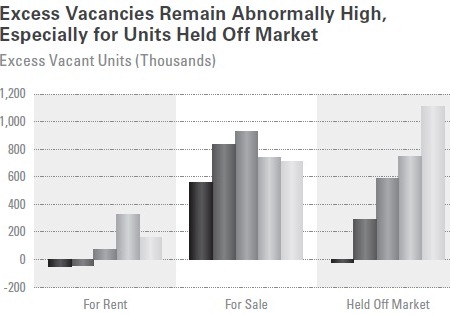- Home owners are stuck in place, millions of them owing more on mortgages than homes are worth, says a new Harvard study. With existing home sales depressed, new home sales are at record lows.
While these findings may seem unsurprising,  the new study - "The State of the Nationâs Housing" released today by the Joint Center for Housing Studies of Harvard University - describes how the residual effects of the downturn, including unemployment and poor access to credit, are keeping buyers from returning downward financial pressures from elevated vacancies and foreclosures, lowering housing prices in the market, especially in the 10 percent of neighborhoods that account for half of all foreclosures.
the new study - "The State of the Nationâs Housing" released today by the Joint Center for Housing Studies of Harvard University - describes how the residual effects of the downturn, including unemployment and poor access to credit, are keeping buyers from returning downward financial pressures from elevated vacancies and foreclosures, lowering housing prices in the market, especially in the 10 percent of neighborhoods that account for half of all foreclosures.
"Where foreclosures are concentrated, property markets are in turmoil," say the researchers.
While lower-priced housing might be expected to spark an influx of home buyers, say Harvard researchers, the lingering impact of the recession and financial crisis are thwarting a broader recovery in new home building, which has suffered three consecutive years of record-low construction levels. In fact, consumers seem to be moving to renting rather than buying, and sellers are holding homes off the market, with more than 1.1 million in an inventory (see chart) that will need to be disposed of, say researchers, before new supplies of home building are demanded of construction companies.
Banks are widely reported to be the largest holders of homes, with more than 1 million reclaimed through foreclosures, and another 1 million expected to be take over by banks in the coming year. This inventory of repossessed homes is also impacting the demand for new construction.
âThe sharp declines in both home prices and interest rates have left homes in many places more affordable than they have been in decades,â says Eric Belsky, managing director of the Joint Center for Housing Studies, but âstubbornly high unemployment and tightened lending standards have limited the ability of many first-time buyers to capitalize on the situation.â
The report says the market could turn quickly, as it did with the 2010 homebuyer tax credit.
Working in the favor of housing recovery for single family homes and for rental construction, which has seen growth recently, are demographics: younger and older households over the coming decade should continue to lift the demand for rental housing as well as for smaller homes. The baby boom generation will push up the number of households over age 65 by some 8.7 million over 2010-2020.
âWhile most of these households will age in place," says Chris Herbert, research director of the Joint Center for Housing Studies, "current mobility rates suggest 3.8 million could downsize over the coming decade, adding further to demand for smaller homes.â
The Harvard Joint Center for Housing Studies report (an executive summary is attached) is among the most watched analyses of the housing market, along with the Case-Schiller Index. In July 2011, Wood & Wood Products magazine will study done jointly with Virginia Tech on the impact of the housing market on the secondary wood products manufacturing industries, an update of a 2010 housing study done by WWP and Virginia Tech last year.






Have something to say? Share your thoughts with us in the comments below.